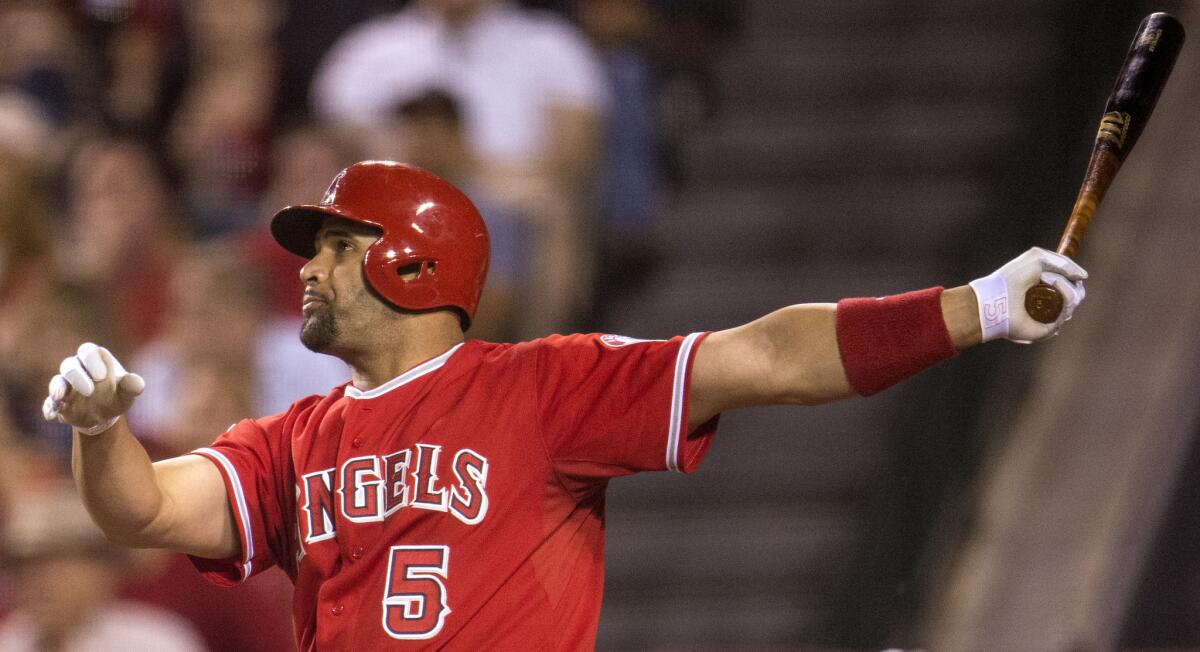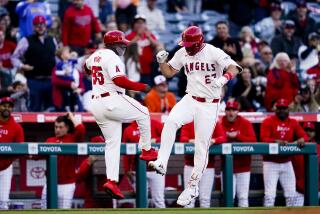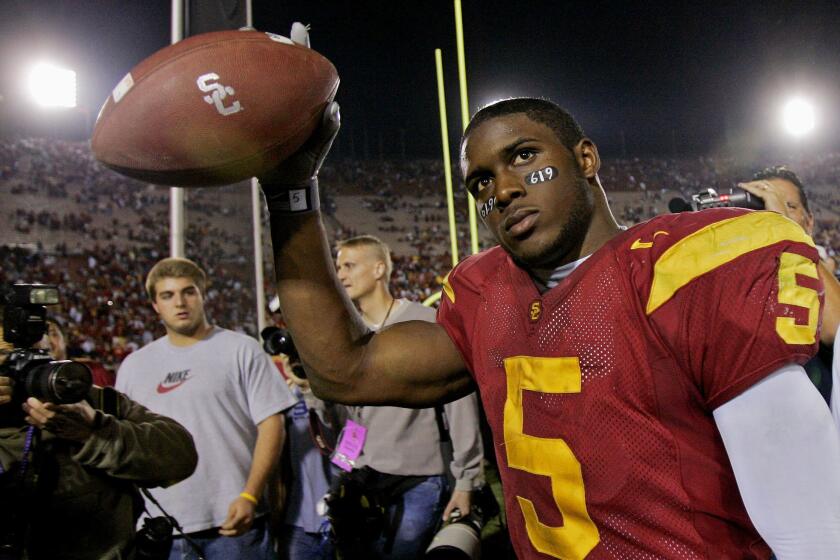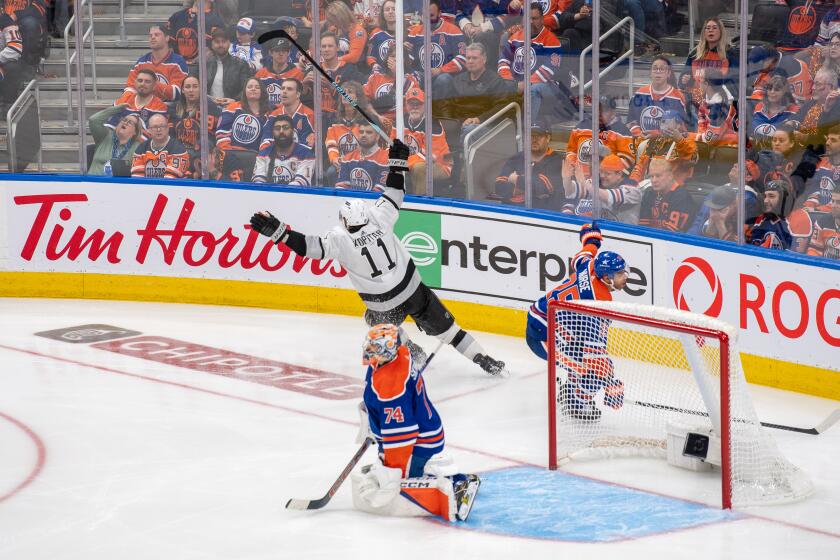MLB is experiencing another power surge

Angels first baseman Albert Pujols follows through on a two-run home run against the Astros on June 22, 2015, in Anaheim.
On the evening of June 16, baseball fans with the right television subscription were treated to an eerie display of power.
It began at 8:18 p.m. on the East Coast, when Todd Frazier of the Cincinnati Reds hit a home run to center field in the fifth innng at Detroit.
Twenty-six minutes later, Bryce Harper of the Washington Nationals hit a home run to center field in the fifth inning against Tampa Bay at St. Petersburg, Fla.
Not long after, Giancarlo Stanton of the host Miami Marlins hit a home run to center field in the fifth inning against the New York Yankees, and later Albert Pujols of the Angels hit a home run to center field in the sixth inning against Arizona at Angel Stadium.
Frazier punctuated the fireworks with another home run, 45 minutes after his first.
“It’s impressive,” said Nelson Cruz of the Seattle Mariners. “Especially in this day and age.”
Cruz led the majors last season with 40 home runs while with the Baltimore Orioles. As of Saturday, 11 batters, including Cruz, were on pace to match that total. Pujols, Frazier and Harper were on pace for 50. Stanton for 60.
Only three times, excluding the steroid era, have multiple players hit 50 home runs in the same season, most recently in 1961, by Roger Maris and Mickey Mantle of the Yankees.
The news that Stanton will sit out four to six weeks because of a broken left hand underlines just how difficult the accomplishment is.
“It’s a big number to reach, especially right now with the era of great pitchers in the game,” said Pujols, whose career best is 49. “But you don’t focus on that.”
In many seasons, one or two players start fast. But this pace, for four players, has been accomplished in only three nonsteroid-era seasons: 1930, 1970 and 1987.
And there’s another 50-home run threat: Nolan Arenado of the Colorado Rockies is on pace for 48.
At the top end, a handful of players are hitting lots of baseballs very far. Last season, there were 50 home runs of 450 feet or more, according to ESPN.com’s home run tracker. As of Saturday, there were 44, and the season isn’t even halfway over.
Remember Stanton’s home run in May that left Dodger Stadium? He has since hit four home runs longer than that.
So where is the power coming from? Dodgers Manager Don Mattingly theorized that the baseballs, completely replaced this year with the new commissioner’s signature, were wound tighter. He was being facetious, but at least it’s a theory.
“I don’t think anybody can answer that question,” Pujols said.
“No clue,” Cruz said.
The more lively argument is whether the rate is sustainable.
The difficulty of hitting 50 home runs is best illustrated by the players who have never done it. Among those were Ted Williams, Lou Gehrig and Hank Aaron.
In his rookie season in 1987, Mark McGwire hit 33 home runs in the first half and finished with 49. In 1969, Reggie Jackson, another slugger who never reached 50, hit 37 in the first half and only 10 in the second.
Pujols said the most important factor is health. Cruz said a hitter has to constantly study to know what to expect from pitchers. And, in a pennant race, he said home runs become an afterthought. There are more situations that call for productive outs or working a walk.
So can Pujols get there?
“I’m not going to play numbers,” Angels Manager Mike Scioscia said. “I think he’s swinging the bat very well. One thing about Albert is, if he needs to move the runner over, he’s going to do it.”
One consequence of baseball’s steroid era has been the fans’ ability to trust. It is impossible to view this year’s home run boom without some skepticism, and already there is talk that the chemists have evolved past the testers.
But for a night, at least, watching five baseballs sail a combined four-tenths of a mile, it was hard not to hope it was clean, and that it continues.
Not closing time
In the 10th inning of the Dodgers’ scoreless tie with the Chicago Cubs on Tuesday, Mattingly waited until the bases were loaded with no outs to summon closer Kenley Jansen. The right-hander is off to an excellent start, but even he couldn’t work out of the jam.
Mattingly was simply adhering to the prevailing strategy. Most managers avoid using their closer in extra innings on the road unless the circumstances are particularly dire or they have the lead.
Why?
Mattingly said he waited to use Jansen because the bottom of the order was due up. Recently, Mattingly went with rookie Josh Ravin in a tie score late on the road because, he said, he knew Ravin could go several innings. It worked once and backfired the next time.
Scioscia said there are a few circumstances when the calculus might change — if the heart of the order is due up, for example, or if the opposing bullpen was taxed. But managers are hesitant to expend their best relievers in a game they may lose anyway or have a lead be squandered by a middle reliever.
“I’m not going to say it would never come up or make sense, but it would have to be some rare circumstances,” Scioscia said.
St. Louis Cardinals Manager Mike Matheny used the same strategy in last season’s National League Championship Series twice with no success. In Game 5, after a starter, Michael Wacha, pitched in relief in the ninth inning and served up a series-clinching three-run home run, Matheney acknowledged it was a bind.
“Just a tough spot for him to be in and not the spot we want him to be in,” Matheny said. “But we’ll put him out there again in a similar situation.”
Change in Philadelphia
When an emotional Ryne Sandberg resigned Friday as manager of the hapless Philadelphia Phillies, he became the fourth manager to be replaced this season.
He joined Milwaukee’s Ron Roenicke, San Diego’s Bud Black and Miami’s Mike Redmond.
How unusual is it for four managers to be dismissed before July?
In the last 10 seasons, nine managers were fired or quit within a team’s first 81 games. Only two of the replacements, Jim Tracy of the 2009 Rockies and Buck Showalter of the 2010 Baltimore Orioles, finished above .500 for the remainder of the season.
More to Read
Get our high school sports newsletter
Prep Rally is devoted to the SoCal high school sports experience, bringing you scores, stories and a behind-the-scenes look at what makes prep sports so popular.
You may occasionally receive promotional content from the Los Angeles Times.







